The natural reflex, in response to a legitimate desire to save money, is to choose to use your tyres until they are threadbare, keeping them as long as possible in order to delay the moment when you have to invest in a set of new tyres.
It’s true that each farm has its own financial priorities which rarely consider agricultural tyres as a primary investment.
The replacement of the head tractor or the acquisition of a new production tool represents a project that is easier to prepare, because the return on investment seems more obvious or at least easier to calculate. Yet there are numerous benefits to be gained from good management of machinery and equipment and more specifically tyres and changing your agricultural tyres just at the right time when wear is optimal is a way of optimising your overall profitability.
Most tyre manufacturers recommend changing your tyres when the lugs are 75% worn, i.e. they have lost three quarters of their height compared to when new.
The legitimate question: why 75% worn and not 90%?
It might initially seem normal to use a product until it is completely worn, but for tyres, the notions of efficiency, productivity and safety must be taken into consideration. The answer to this question will therefore not be the same for everyone; there is no absolute rule and it will depend on your most frequent use of the tractor.
- Depending on the type of soil and crops, the average lifespan of rear tyres varies between 2000 hours and 3500 hours and between 1700 hours and 3000 hours for front tyres.
- This lifespan in hours obviously varies depending on the type of soil, with sloping flint soils causing more rapid wear than flat clay or sandy soils.
1. If you use your tractor essentially in the fields
When you exceed 75% wear, you will begin to feel the negative effects in terms of performance. As the wear is progressive, these effects are not flagrant, yet without you having noticed, performances begin to slip and you are far from your vehicle’s original efficiency.
When the lugs are more than 75% worn, your agricultural tyre encounters more problems with traction, especially on wet ground. Your tractor’s overall efficiency is reduced, independently of its power which does not weaken.
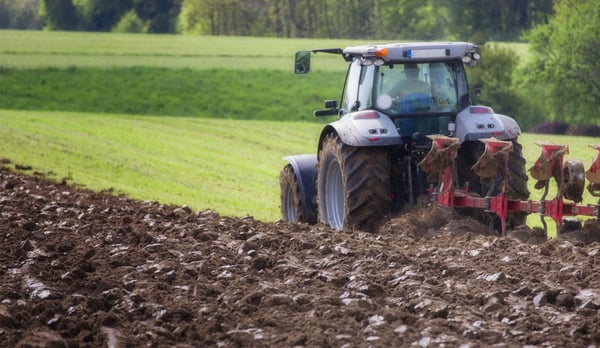 Tyre wear with work in the fields
Tyre wear with work in the fields
When working in the fields, it is via your tyre lugs that engine power is transmitted to the ground, providing your vehicle and its trailer with good traction.
If your lugs are more than 75% worn, they no longer guarantee optimal traction, resulting in more slippage on wet, loose ground, irrespective of the inflation pressure at which the tractor operates.
Extended use will lead to irregular wear and will therefore accentuate the loss of motricity as well as affecting the quality of driving on the road and as such safety and comfort.
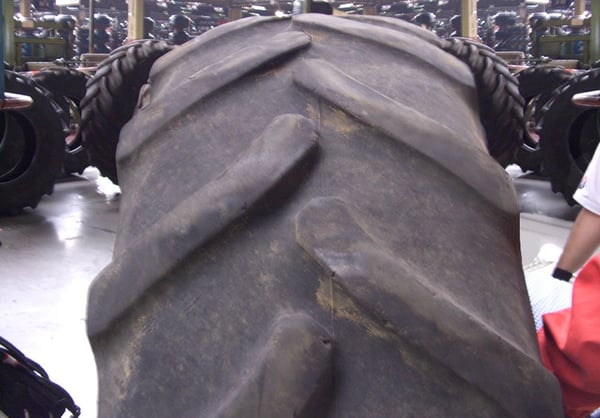
No doubt you know that working at low inflation pressure increases the tyre’s contact patch with the ground and therefore improves traction, but with lugs that are more than 75% worn, i.e. with three times less height, you reduce the tyre’s capacity to grip the ground by half. This significantly reduces the transmission of tractive force and means that you will lose a considerable amount of time, especially if you have a lot of land to cover.
Increased slippage results in an increase in fuel consumption as well as a loss of time. Driving with tyres that are more than 75% worn is therefore not the best way to make savings; on the contrary, it will just reduce your productivity, impacting your yields more globally. In addition, your grip is weakened which will lead to more slipping and sliding which will inevitably damage your soil.
2. If you use your tractor essentially in the courtyard or for transport by road
When you drive on the road, you can keep going without any problem as far as 85% wear. This represents 85% of the height of the lugs on a new tyre. The height of the lugs is effectively not used when driving on hard ground or asphalt.
You can make your tyres last longer by always driving at the right inflation pressure. Be careful, pressure must always be higher on the road to decrease the tyre’s contact patch with the ground and reduce rolling resistance.
Nonetheless, you must know that the road surface is much more abrasive than earth and by driving with a heavy load at high speed, the rubber heats up rapidly when in contact with the ground and weakens the different layers making up the tyre, including the lugs.
Frequent accelerations and hard braking therefore accelerate wear to the rubber of agricultural tyres, whose main function is not to be driven on hard ground or asphalt, but rather on loose soils.
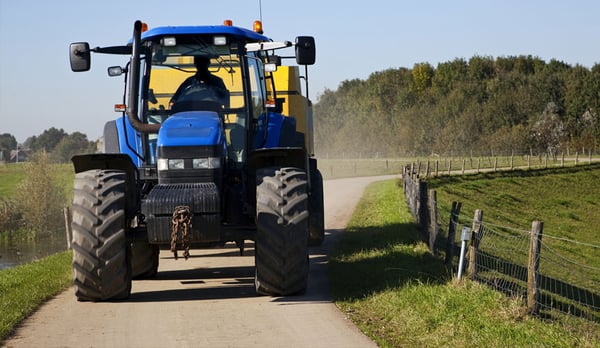 Tyres: wear linked to transport by road
Tyres: wear linked to transport by road
Obviously, you can go well beyond 75% wear if you stay in the farmyard with no impact on your work or productivity. Frequent use for manoeuvres, to load or unload straw, feed the animals, etc. may lead to premature wear to your agricultural tyres.
In addition to the reduction in height of the lugs, wear can generally be seen in the form of cuts on the tips of the lugs or the sidewalls of the tyre, which may have various origins: stony ground, uneven surfaces in the courtyard, tools or metal objects on the ground, etc.
What are the risks of keeping tyres beyond the minimum rate of wear?
Even if it is possible to drive with a tyre that is over 75% worn, it is highly recommended that you never let your lug height go below a minimum of 10 mm, because beneath this limit the tyre is really worn and will no longer do its job in terms of safety. The risk of accidents is real and may be irreversible.
If you get down to 10 mm in lug height with normal use in the fields and moderate use on the road, your tyre has run its course and you may encounter problems linked to the natural ageing of the components, such as an alteration of the structure of the polymers or other chemical effects to the rubber with which the tyre is made.
When driving with tyres that are too old, the risks increase: damage, punctures or accidents.
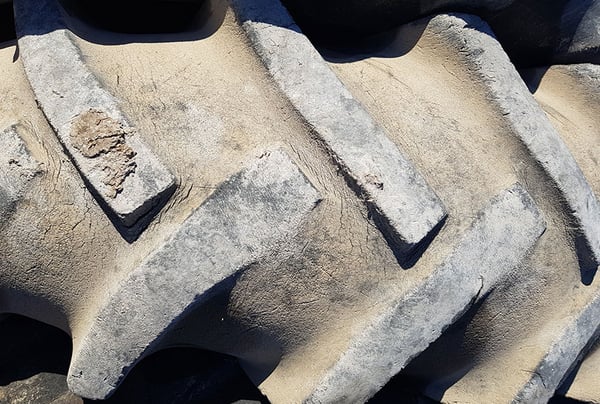 Excessive ageing and lugs too short
Excessive ageing and lugs too short
When the minimum level of lug wear is not respected, you may damage the internal structure of your agricultural tyre directly. Whether you are driving on the road or in the fields, the risk of damages appearing increases in proportion to the level of wear and this may be due to just a branch, a root, a stone, a pothole in the road or a small frontal or lateral knock.
Following a slight impact to a worn tyre, the appearance of a small hernia on the tread or the sidewall of your tyre during inflation is an early warning sign that your tyre may burst, especially if you are transporting heavy loads during harvesting for example.
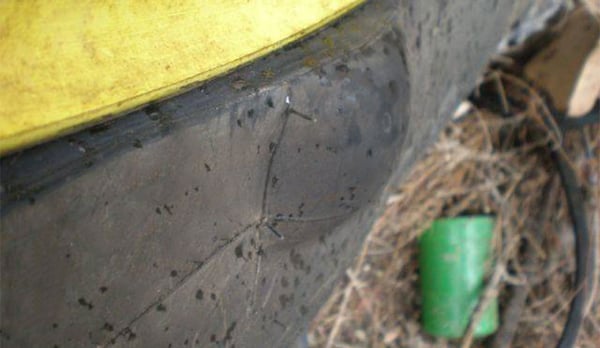 Appearance of a hernia on the tyre sidewall, during inflation
Appearance of a hernia on the tyre sidewall, during inflation
The risk of bursting also becomes omnipresent, it increases with the level of wear and may occur at any moment. The slightest obstacle (pebbles, stones, branch, metal object) may result in your agricultural tyre bursting, because the reduced height of the lugs means that the inner tread structure is no longer protected, and cuts become inevitable. You therefore run the risk of immobilising your trailer any time, anywhere.
Financial losses will be even higher if the vehicle is immobilised in an inconvenient place.
In any case, you will need to call in a professional to carry out repairs on-site, which will be relatively costly and will generally require the replacement of both tyres of a given axle.
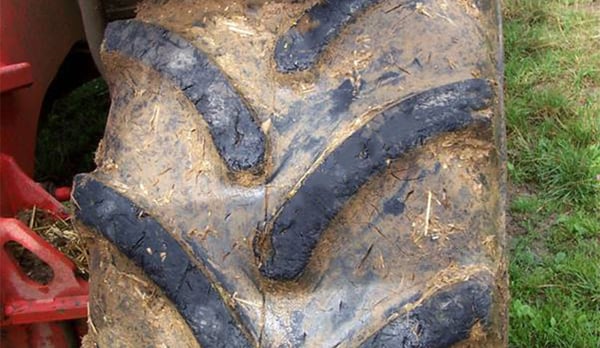 Cuts on the inner tread structure
Cuts on the inner tread structure
Beyond any immobilisation or accidents which may occur due to the use of worn tyres, the applicable regulations prohibit driving on the road with tyres that are even slightly damaged.
The law stipulates that the tread pattern must be clearly visible over the entire surface of the tyre and there must not be any cuts or deep tears on the sidewalls. The internal components (mesh…) must never be visible on the surface or on the sidewalls, nor on the inner tread structure.
High fines may be imposed for this type of wear and lead to the vehicle being immobilised with an obligation to have repairs carried out on-site.
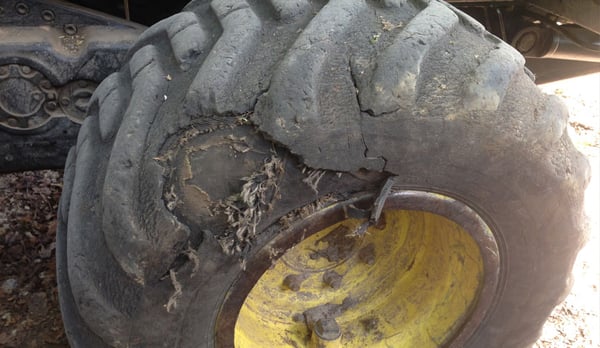
What is the best replacement strategy?
Ideally, you should find the best compromise between the benefit linked to the efficiency of the new tyre and the cost of replacement of your worn tyre. You should make the most of the new tyre by optimising the replacement investment.
Bear in mind that the early replacement of the tyre costs less than the cost of breakdown services followed by tyre replacement, without mentioning immobilisation in a place that is inconvenient or difficult to access, or the time during which your machinery is immobilised, which are all elements to be taken into consideration.
Here is the optimal solution:
- Purchase new tyres on credit if you can obtain a low interest rate
- Sell your 75% worn tyres on the second-hand market
- Then do the same again
With this solution, you never block large amounts for your tyre investment. You will have low and regular fixed costs for your tyres with a cash inflow when you sell the second-hand tyres and you will always have new or recent equipment to boost your efficiency and productivity.
1. How to estimate the selling price of a 75% worn tyre?
The selling price on the second-hand tyre market depends on several criteria:
- The brand: given that a reputed brand is worth much more than a little or unknown brand. When you buy a new set of tyres, the brand is a non-negligible guarantee of quality, so do your research in order to avoid unpleasant surprises and be certain to find a buyer when you are ready to sell.
- The level of wear: is also a very important factor in estimating the selling price of a second-hand agricultural tyre. For example, for a new tyre with 60 mm lugs, you can make a good sale with wear of around 15 to 20 mm. Within this limit, it is still possible to obtain a good price on the second-hand market to amortise your investment in a new set of tyres.
2. Buying new tyres on credit with a low interest rate
Buying a new set of agricultural tyres represents a major investment.
The current rates are low and the slight additional cost is easily offset by the fuel savings you will make during the first year of use. New tyres are effectively good for your productivity because they optimise the transmission of your tractor’s engine torque and tractive force.
You will therefore gain in power, and as such speed of work and instead of working longer with worn tyres, you will be able to cover a larger surface area during the day with new tyres. You will also avoid excessive slippage thanks to the new lugs, which considerably reduce fuel consumption and damage to your soil.
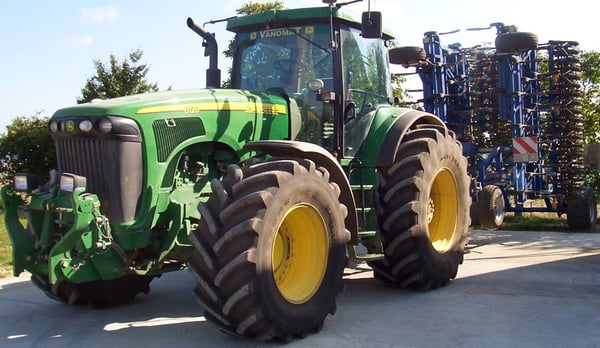
When you buy new tyres on credit, you will have an inflow of cash thanks to the sale of your second-hand tyres, without any corresponding investment, since the purchase is covered by the bank.
You will therefore have positive cash flow and a pair of new tyres to allow you to do the work quicker and make immediate fuel savings.
To help you clearly define the causes of premature wear on your current tyres, we have developed a complete guide for you to download free of charge "How to detect abnormal wear in my tractor tyres"

Most people who read this article have also read some of the following articles:
This information is intended only to make you aware of the technical and functional aspects of agricultural tires and their use. It does not allow you to make a judgment or a definitive conclusion on a given problem. Only your agricultural tire expert is able to make a technical assessment and take a final decision, case by case.